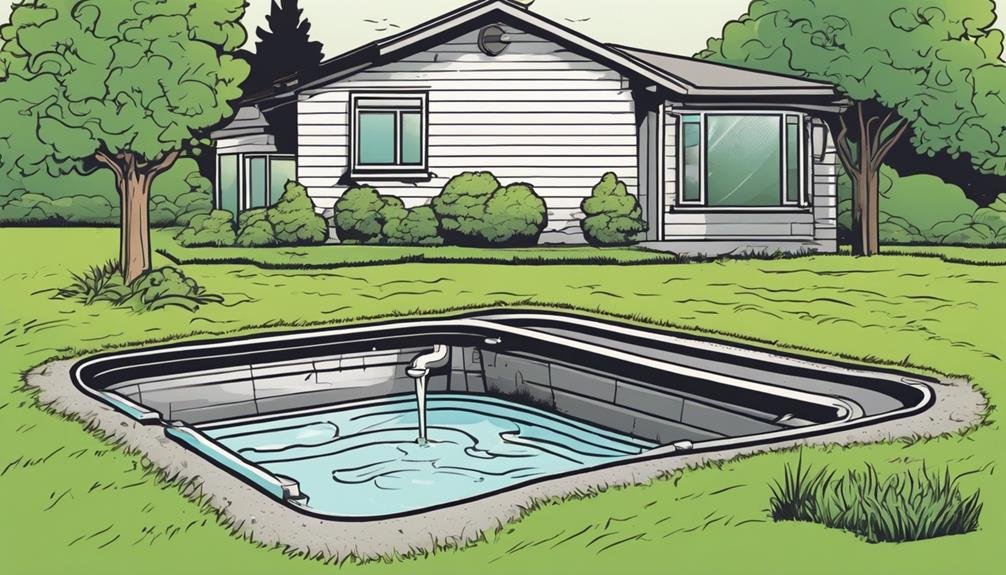So, you've noticed some strange occurrences around your septic tank lately. Foul odors, slow drains, and unusual noises are just some of the signs that might be pointing to a blocked septic tank.
But what could be causing these issues, and how can you tackle them effectively to ensure your septic system functions smoothly? Let's explore the common culprits and practical solutions that can help you avoid a messy situation down the line.
Key Takeaways
- Regular septic tank maintenance prevents issues like foul odors and slow drainage.
- Timely pumping every 3 to 5 years prevents overfilling and blockages.
- Identifying symptoms of septic system failure is crucial for preventing environmental contamination.
- Use drain strainers and avoid pouring grease down the drain to prevent clogged drains.
Common Signs of Septic Tank Blockage

If you notice foul odors emanating from your drains or slow drainage in your plumbing fixtures, you may be experiencing common signs of a septic tank blockage. Regular septic tank maintenance is crucial to prevent such issues. To tackle this problem effectively, consider seeking professional help.
Septic tank blockages can occur due to various reasons such as the buildup of solid waste, grease, or foreign objects in the system. Ignoring these signs can lead to more severe problems like sewage backups or damage to your septic system. In some cases, attempting to resolve the blockage without proper knowledge and tools can worsen the situation.
To address septic tank blockages efficiently, it's advisable to consult with a professional septic tank service provider. These experts have the necessary equipment and expertise to identify the root cause of the blockage and implement appropriate solutions. By entrusting the task to professionals, you ensure that the issue is resolved effectively, minimizing the risk of further complications and ensuring the smooth operation of your septic system.
Indications of a Full Tank
To determine whether your septic tank is full, observe the level of solids and scum inside the tank regularly. Tank maintenance is crucial to prevent issues. If you notice that the solids and scum are approaching the outlet pipe, or if you observe slow drainage in your sinks and toilets, these are indications that your tank may be reaching its capacity. It's recommended to have a pumping schedule in place to avoid overfilling your tank. Regularly pumping your septic tank every 3 to 5 years, depending on usage, can help prevent blockages and maintain the system's efficiency.
Monitoring the level of solids and scum in your tank is essential for proper tank maintenance. By staying aware of these indicators and following a pumping schedule, you can prevent potential issues with your septic system. Remember, a well-maintained septic tank is key to avoiding costly repairs and ensuring the longevity of your system.
Symptoms of a Failing Septic System

Early identification of symptoms indicating a failing septic system is crucial for timely intervention and preventing costly damages. If left unaddressed, a failing septic system can lead to environmental contamination and health hazards.
Here are three key symptoms to watch for:
- Pooling Water: Notice pools of water forming near the drain field or septic tank. This could indicate a leak or overflow, signaling a potential issue with the system's drainage or absorption capabilities.
- Foul Odors: Unpleasant smells around the septic tank or drain field are a red flag. These odors might suggest a buildup of waste material, a leak, or an ineffective drainage system.
- Slow Drains: If you observe slow drainage in sinks, toilets, or showers, it could point to a failing septic system. This sluggishness indicates a blockage or a full tank, requiring prompt attention to prevent further damage.
Regular septic system maintenance and timely repair solutions are essential to ensure the system operates efficiently and avoids costly breakdowns.
Warning Signs of Clogged Drains
Clogged drains can manifest through various warning signs that signal potential issues within your plumbing system. One common indication of a clogged drain is slow drainage. If you notice water taking longer than usual to drain from sinks, showers, or tubs, it may be a sign of a blockage forming in the pipes.
Another warning sign is water backing up in different fixtures. For instance, if flushing the toilet causes water to rise in the shower drain, there could be a blockage in the main sewer line. Foul odors emanating from drains are also a red flag, as they can indicate trapped food particles or other debris causing a clog.
To prevent such issues, regular drain maintenance is crucial. Simple practices like using drain strainers, avoiding pouring grease down the drain, and periodically flushing drains with hot water can help in blockage prevention. By staying vigilant and implementing these measures, you can maintain a healthy plumbing system and prevent potentially costly repairs.
Conclusion
In conclusion, when it comes to identifying and resolving blocked septic tank issues, it's crucial to pay attention to warning signs such as slow draining sinks and foul odors.
Ignoring these red flags could lead to costly repairs and potential health hazards. Remember, a stitch in time saves nine, so addressing septic tank problems promptly can prevent bigger issues down the line.
Stay proactive and keep your septic system in top shape to avoid any unnecessary headaches.

